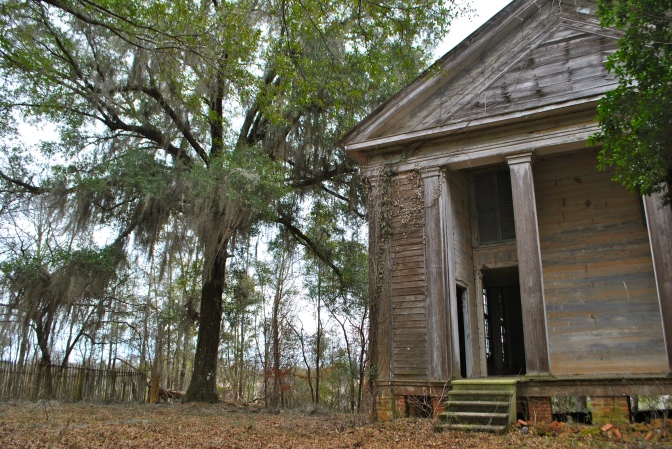Down a narrow country road in rural Dallas County, Alabama stands an old church. Just off the black top, its glass-less windows staring out like dark eyes with a sinister secret. The church is enclosed by a fence with an old cattle gate pulled tight to keep out those passing by.

On the day I visited, it was a beautiful day, but as soon as I jumped the ditch and started climbing the small embankment leading to the fence around the church, the atmosphere became all together different. It was quiet. Just the wind through the trees and the far off bellowing of cattle some distance away, but something about this place made the hair on the back of my neck rise.
I knew nothing about it. We simply decided to stop by on our way to Selma because I wanted to take some pictures. The facts were simple enough – Adams-Grove Presbyterian Church. Built in the early 1850’s. Put out of service in the 1970’s. Sitting on private property, along with a cemetery that is older than the church. It was the atmosphere around the place that would stick with me. Something about it was eerie, as if someone was standing in the shadows of the gaping doorway, staring at you like you weren’t suppose to be there.

I didn’t get much closer than the fence and could barely make out some of the tombstones in the cemetery. I could have skirted the gate and gotten closer, but every instinct told me I wasn’t welcome. I didn’t know it at the time, but apparently several paranormal investigators have visited the church and adjoining cemetery. There is said to be a man, dressed all in black that roams the grounds. Another report is of a Confederate soldier that orders visitors away when seen. Although I didn’t meet either of these ghosts (thank goodness!), this place definitely has a creepy feel about it.

The oldest identified grave in the small, adjoining graveyard is that of Elizabeth Cooper Jones. She was born in 1776 and her husband, Seaborn Jones, fought as a private from Georgia during the American Revolution. He died in 1815 and is buried in Augusta, Georgia. It seems Elizabeth came with her youngest child, daughter Elizabeth Seaborn Jones Walker, to Dallas County just before the Civil War.
Elizabeth Seaborn Jones married Dr. John Valentine Freeman Walker in Georgia in the 1830’s. John V. F. Walker fought in the Civil War and was wounded at Appomattox. Apparently he had 14 bales of cotton on their way to New York that were captured by Federal troops in 1865.
Dr Walker was one of the wealthiest farmers in the area according to the 1860 census. Just before the war, he was worth between $160-$170K. By the time of the next census in 1870, he would be dead. His widow, Elizabeth Seaborn Jones Walker, was listed as “keeping house” on the 1870 Federal Census. By then, she was living with her son, Howard, on an estate worth only $5800. Such is the way of war. Both Virginia and Robert, her two other children are also buried in the cemetery.

Another grave is that of Rebecca Sorrell Adams. Her father was the original landowner and conveyed the land to two deacons of a nearby church in Sardis. The condition imposed was that if the land was ever used for anything other than a church, it would revert back to Sorrell. When the Sardis Church moved away, Rebecca and her husband, Henry Adams, ended up receiving the land back in the 1850’s before selling part of the plot (including the cemetery) to the trustees of a new church. This new church is the one standing today.

The stories of the people in the graveyard tell the story of a community that no longer exists. Ravaged by war and time, only bits and pieces survive in records to indicate how these people ended up in such a remote area in the middle of the Alabama Black Belt. Most were not born here, but they lived and died here…and apparently something of them still remains.
Awesome post. That’s just the sort of experience that I really enjoy!
LikeLike
Thanks…and me too! 😉
LikeLiked by 1 person
I shared this.
LikeLike
This place is right up my alley! I love aging, decayed properties because they take on a charm of their own. Thanks for these interesting pictures! And thanks for following Oh, the Places We See. Here’s hoping you enjoy traveling with us, too!
LikeLike
Thanks! I love your blog! I’m a fellow Southerner (Alabama) and it looks like we have lots in common! 🙂
LikeLike